Haryana State Board HBSE 10th Class Science Solutions Chapter 8 How do Organisms Reproduce? Textbook Exercise Questions and Answers.
Haryana Board 10th Class Science Solutions Chapter 8 How do Organisms Reproduce?
HBSE 10th Class Science How do Organisms Reproduce? Textbook Questions and Answers
Question 1.
Asexual reproduction takes place through budding In
(a) amoeba
(b) yeast
(c) plasmodium
(d) leis mania
Answer:
(b) yeast
![]()
Question 2.
Which of the following is not a part of the female reproductive system in human beings?
(a) Ovary
(b) Uterus
(c) Vas deferens
(d) Fallopian tube
Answer:
(c) Vas deferens
Question 3.
The anther contains
(a) sepals
(b) ovules
(c) pistil
(d) pollen grains
Answer:
(d) pollen grains
Question 4.
What are the advantages of sexual reproduction over asexual reproduction?
Answer:
The advantages of sexual reproduction over asexual reproduction are as follows:
1. Sexual reproduction involves fusion of male and female gametes from male and female parents to form zygote. Thus, new generation shows variation as DNA copies from two different individuals are received.
2. Sexual reproduction involves gamete formation. Meiosis takes place during male and female gamete formation and new combination of genes occur during meiosis. This also leads to variation. Combining variation from two individuals would create new combination of variants.
3. Sexual reproduction create variation generation after generation, which is useful for survival of species over time.
4. The inbuilt tendency for variation during sexual reproduction is the basis for evolution.
![]()
Question 5.
What are the functions performed by the testes ¡n human beings?
Answer:
Testes does two functions.
- To produce sperms (male sex cells) and
- To produce hormone called testosterone.
Question 6.
Why does menstruation occur?
Answer:
When egg is not fertilized, the thick-spongy and highly vascular inner inning of uterus breaks. This causes menstruation in woman.
Question 7.
Draw a labeled diagram of the longitudinal section of a flower.
Answer:
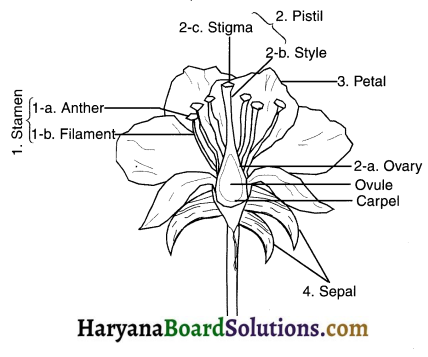
Flowering plants belong to the group of angiosperms. The reproductive parts of angiosperms are located in the flower. So, we can say that flower is the reproductive organ of the plant. The four main reproductive parts of a flower are:
- Stamen
- Pistil
- Petal and
- Sepal
![]()
Stamen and pistil contain germ-cells (gametes).
1. Unisexual flower: If the flower contains only one part out of stamen or pistil then such a flower is called unisexual. For example, papaya and watermelon.
2. Bisexual flower: If the flower contains both stamen as well as pistil the flower is called bisexual For example. hibiscus and mustard.
3. Male reproductive part: Stamen is the male reproductive part. It produces yellowish-coloured pollen grains. Stamen is made up of two parts namely
- anther and
- filament.
4. Female reproductive part:
Pistil (or carpel) is the female reproductive part. It is present at the centre of a flower. It is made of three parts namely,
- ovary,
- style and
- stigma.
The swollen bottom part is the ovary, middle elongated part is the style and the terminal part which may be sticky is the stigma. The ovary contains ovules and each ovule contains an egg cell.
Question 8.
What are the different methods of contraception?
Answer:
Contraception :
The method to prevent pregnancy in women is called contraception. Methods adopted to prevent pregnancy are called contraceptive methods.
Methods:
(1) Birth control tools:
- Under this method, a mechanical barrier is created which prevents the entry of sperm into the genital tract. As a result, fertilization does not occur.
- The tools include condoms to be worn on penis and/or diaphragm worn in the vagina by female.
- Another tool is placing lntra-Uterine Contraceptive Devices (IUCDs) like Copper-T into the uterus of females to prevent pregnancy.
(2) Birth control pills:
There are oral pills that a women can take. These pills change the hormonal balance of the body so that the eggs are not released by the ovaries and fertilization is prevented.
(3) Surgical methods:
- In males, a small portion of the vas deferens is surgically removed or tied.
- This process is known as vasectomy and it prevents the sperms from entering urethra.
(Note: ectomy means to remove by surgery) - In females, the fallopian tube is surgically cut and tied. This process is known as tubectomy. It will not allow the sperm to reach the uterus.
(4) Abortion:
Another method is to surgically remove the foetus from the body of pregnant women. However, this is not a method to prevent pregnancy but to prevent child-birth after pregnancy.
![]()
Question 9.
How are the modes for reproduction different in unicellular and multicellular organisms?
Answer:
1. In unicellular organisms, reproduction occurs by simple cell division. For example, through fission and budding.
2. Multi-cellular organisms have complex body organization. So, they have a complex method of reproduction. They undergo sexual reproduction.
Question 10.
How does reproduction help in providing stability to populations of species?
Answer:
1. Every organism that takes birth has to die. if organisms do not reproduce, their species will become extinct.
2. Species can reproduce and gives rise to new offspring. This gives stability to its population.
Question 11.
What could be the reasons for adopting contraceptive methods?
Answer:
Reasons for adopting contraceptive method:
- To prevent unwanted pregnancies –
- To control human population
- To prevent the transmission of sexually transmitted disease.
HBSE 10th Class Science How do Organisms Reproduce InText Activity Questions and Answers
Textbook Page no – 128
Question 1.
What Is the importance of DNA copying in reproduction?
Answer:
Importance of DNA copying:
- For continuity of species
- For transmitting hereditary information of parents to off-springs.
- Occurrence of variation in DNA copying, leads to evolution of a species and its better adaptability to its surroundings.
Question 2.
Why is variation beneficial to the species but not necessarily for the individuals?
Answer:
1. DNA copying occurs at the time of reproduction. DNA copying shows some variations.
2. The variations may not benefit an individual all the time, but when such variations keep on taking place over generations within a large population, they may bring some changes in the species. These changes may help the generation to be better adaptive to the changing surroundings.
3. Thus, variation in individual may not seem beneficial but when studied from the point of view of entire species, it may be beneficial.
Textbook Page no – 133
Question 1.
How does binary fission differ from multiple fission?
Answer:
|
Binary fission |
Multiple fission |
| 1. The parent nucleus divides into two parts. 2. Cyst is not formed. 3. Amoeba and paramoecium reproduce through binary system. |
1. The parent nucleus divides into several parts. 2. A cyst is formed around the organism. 3. Amoeba and plasmodium reproduce through multiple fission. |
Question 2.
How will an organism be benefited if it reproduces through spores?
Answer:
1. Spore can survive under unfavourable conditions as they are covered by a hard protective coat.
2. Spores can also be carried away easily by agents like wind, water, etc.
![]()
Question 3.
Can you think of reasons why more complex organisms cannot give rise to new individuals through regeneration?
Answer:
More complex organisms cannot give rise to new individuals through regeneration because
- In complex organisms, there are specialized cells for performing different functions as well as specialized functions.
- Complex organisms have tissues and organs which cannot be produced through regeneration. Moreover, the regenerative ability of complex organism is lost due to specialization of tissues and organs.
- Specialized cells needed to conduct regeneration are not present in complex animals.
Question 4.
Why Is vegetative propagation practiced for growing some types of plants?
Answer:
Advantages of vegetative propagation:
- Plants raised by vegetative propagation can bear flowers and fruits earlier than those produced from seeds.
- Vegetative propagation is also helpful in growing plants such as banana, orange, rose and jasmine that have lost the capacity to produce seeds.
- The plants produced are genetically similar to the parent plant and so have similar characteristics as the parent plant.
Question 5.
Why is DNA copying an essential part of the process of reproduction?
Answer:
The first and foremost task of the reproduction process is to make copies of blueprints of body design’. This is done by creating copies of DNA.
- Through DNA copying the genetic information of parents is passed to next generation.
- DNA present in the nucleus of the cell is the source of information for making proteins which helps in designing the body.
Textbook Page no – 140
Question 1.
How is the process of pollination different from fertilization?
Answer:
1. In pollination, there occurs the transfer of pollen grains from anther of the stamen to the stigma of the carpel. So, the main process is transfer of pollen grains.
2. In fertilization, the male gamete fuses with female gamete to form a zygote. So. fertilization is the process of fusion of germ cells.
Question 2.
What is the role of the seminal vesicles and the prostate gland?
Answer:
The seminal vesicles and prostate gland secrete fluids which make transport of sperms easier. Moreover, the fluid also provide nutrition to the sperms.
Question 3.
What are the changes seen girls at the time of puberty?
Answer:
1. The size of the breasts starts increasing. The nipples become dark.
2. The ovary starts secereting female sex hormones. Hence, girls begin to menstruate at around this time.
3. Hair start growing in pubic area and in arm-pits.
![]()
Question 4.
How does the embryo get nourishment inside the mother’s body?
Answer:
1. The embryo gets nourishment from the mother’s blood with the help of special tissue called placenta.
2. The placenta contains villi on embryo’s side. Glucose, oxygen and important nutrients pass via. villi from the mother to embryo. This is how the embryo gets the nutrition.
Question 5.
If a woman is using a copper-T, will it help In protecting her from sexually transmitted diseases?
Answer:
No, copper-T does not restrict the flow of fluid that enters the vagina. Hence, if the women involves in sex with a person affected with a sexual disease, the fluid from the affected person’s body can enter into the women’s body and cause her sexual disease.
Activities
Activity 1.
Aim: To observe a sexual reproduction method of budding in yeast.
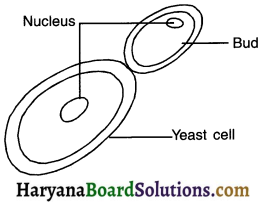
Procedure:
- Dissolve about 10 gm of sugar in loo mL of water.
- Take 20 mL of this solution in a test tube and add a pinch of yeast granules to it.
- Put a cotton plug on the mouth of the test tube and keep it in a warm place.
- After 1 to 2 hours, put a small drop of yeast culture from the test tube on a slide and cover it with a coverslip.
- Observe the slide under a microscope.
Observation and conclusion:
- We can see budding occurring in yeast cells. The nucleus of the cell divides.
- Bud is an outgrowth on yeast cell surface which develops due to cell division. Here, budding has shown the asexual method of reproduction.
Activity 2.
Aim: To study growth of fungus called rhizopus on a piece of bread.
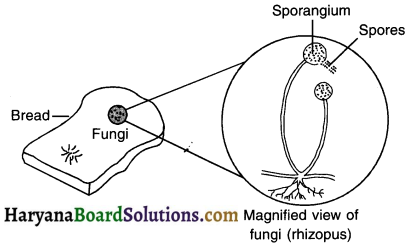
Procedure:
- Wet a slice of bread, and keep it in a cool, moist and dark place.
- Observe the surface of the slice with a magnifying glass.
- Record your observation for a week.
Observation:
A white cotton-like mass appears on the moist bread which is known as bread mould. Mould is a type of fungus. Later, in most cases it becomes black to produce sporangia which produces spores.
Conclusion:
- We will be able to see a scattered white cotton type structure on the moist bread. This is called bread mould or fungus.
- The fungus grown is rhizopus. It becomes black to produce sporangia which produce spores.
Activity 3.
Aim: To observe amoeba and its binary fission under a microscope

Procedure:
- Observe a permanent slide of amoeba under a microscope.
- Similarly, observe another permanent slide of amoeba showing binary fission.
- Now, compare the observations of both the slides.
![]()
Observation and conclusion:
It can be seen in the slide that amoeba is a unicellular microscopic organism. It does not have an shape i.e. its shape Is irregular.
Binary fission in amoeba:
- While studying the binary fission in amoeba, we can see that first its nucleus elongates and the divides into two parts.
- After that the cytoplasm divides into two parts. The cytoplasm gets accumulated around each nucleus. This results in two daughter cells. Each daughter cell grows into an adult organism.
Activity 4.
Aim: To observe filamentous algae under a microscope

Procedure:
- Collect water from a lake or pond that appears dark green and contains filamentous structures.
- Put one or two filaments on a slide.
- Put a drop of glycerine on these filaments and gently cover it with a coverslip.
- Observe the slide under a microscope.
- Can you identify different tissues in the spirogyra filaments?
Observation and conclusion:
- Spirogyra has a filament type structure. It is a multicellular organism which is in the form of green coloured algae.
- We can observe that the different cells of the spirogyra filament are alike and there is no tissue differentiation.
Activity 5.
Aim: To study vegetative propagation in potato
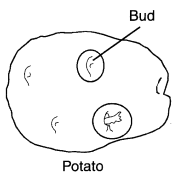
Procedure:
- Take a potato and observe its surface. Can notches be seen?
- Cut the potato into small pieces such that some pieces contain a notch or bud and some do not.
- Spread some cotton on a tray and wet it. Place the potato pieces on this cotton. Note where the pieces with the buds are placed.
- Observe changes taking place in these potato pieces over the next few days. Make sure that the cotton is kept moistened.
- Which potato pieces give rise to fresh green shoots and roots?
![]()
Observation and conclusion:
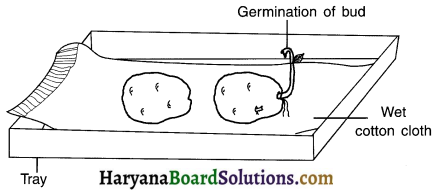
New plant grew from that part of potato which had notches (or say buds) whereas the other piece of potato that did not have notches (buds) did not show growth of a new plant.
Activity 6.
Aim: To study vegetative propagation by stem cutting.
Procedure:
- Select a money plant.
- Cut some pieces such that they contain at least one leaf.
- Cut out some other portions between two leaves.
- Dip one end of all the pieces in water and observe over the next few days.
- Which ones grow and give rise to fresh leaves?
- What can you conclude from your observations?
Observation and conclusion:
- The piece which has at least one leaf develops into fresh leaves and branch. The reason for this is that the money plant contains an auxiliary bud between leaf and stem. This bud develops into new i.e. fresh leave.
- The other piece i.e. the inter-node piece does not bear buds and.So fresh leaves do not develop on this piece.
Activity 7.
Aim: To observe parts of a seed
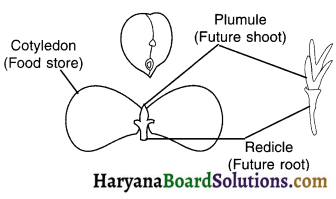
Procedure:
- Soak a few seeds of Bengal gram (chana) and keep them overnight.
- Drain the excess water and cover the seeds with a wet cloth and leave them for a day. Make sure that the seeds do not become dry.
- Cut open the seeds carefully and observe the different parts.
- Compare your observations with the figure and see if you can identify all the parts.
![]()
Observation and conclusion:
- The seed consists of two cotyledon i.e. it is dicotyledon.
- When the seed starts growing, it shows the growth of shoot called pumule’. In future, the root will develop which will be called ‘radicle’.
- Radicle comes out of the seed during first germination.